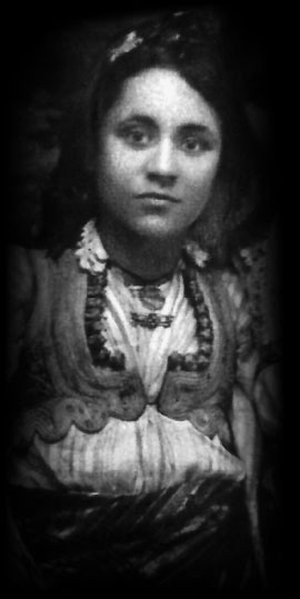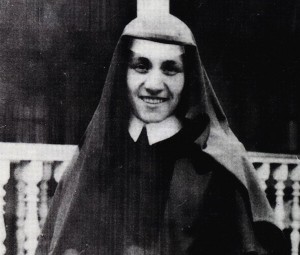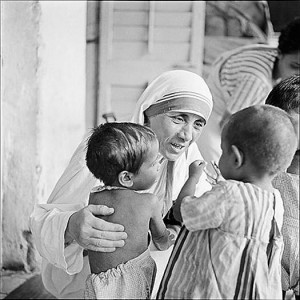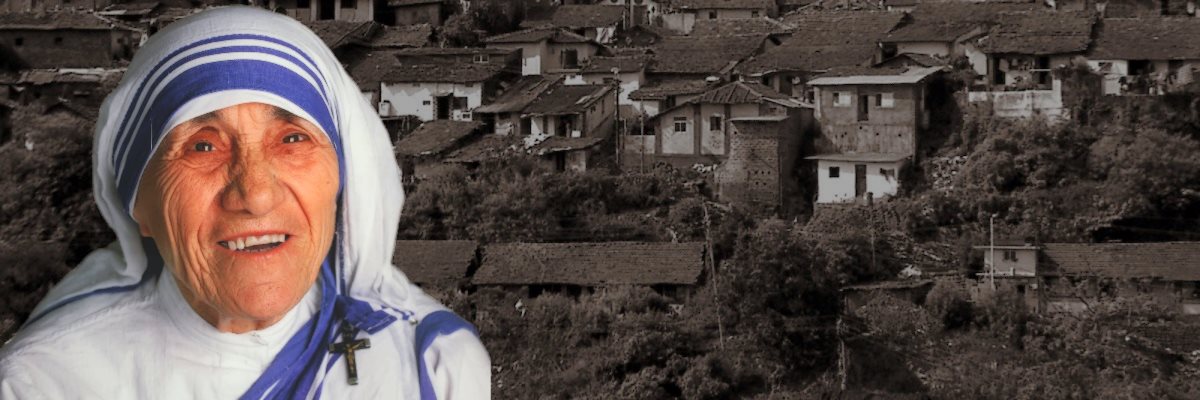On 11 December 1979, Oslo – and the rest of the world – was still under the impression of the event from the day before: the awarding of the Nobel Prize for Peace, a prize bestowed upon Mother Teresa of Calcutta.
As it was accustomed, Mother Teresa was delivering a speech that day at the Oslo University. This is an occasion more important than the awarding of the prize itself, because the laureate has the opportunity to express his or her points of view upon a particular matter, and has the possibility to communicate a message to the world.
Since then, the world has evolved economically, technologically, socially… But the majority of the issues raised in that speech are still fundamentally valid even today. Beyond the small verbal stuttering of a woman who was not a native speaker of English, beyond the delivery of a speech which was not coherent at all times, beyond some opinions which might differ from yours, there are some passages speaking about life which simply touch your soul. Largely, the speech is a sequence of parables. But not like the ones skillfully made up by wise people. These are some actual life-experiences with which Mother Teresa encountered on a daily basis. Life-experiences that are painful, but happy in the same time.
I should better let you read the transcript, with notes which bring some extra information…

As we have gathered here together to thank God for the Nobel Peace Prize I think it will be beautiful that we pray the prayer of St. Francis of Assisi which always surprises me very much.
We pray this prayer every day after Holy Communion, because it is very fitting for each one of us, and I always wonder that 4-500 years ago as St. Francis of Assisi composed this prayer that they had the same difficulties that we have today, as we compose this prayer that fits very nicely for us also. I think some of you already have got it, so we will pray together.
Lord, make a channel of Thy peace
that, where there is hatred, I may bring love;
that where there is wrong, I may bring the spirit of forgiveness;
that, where there is discord, I may bring harmony;
that, where there is error, I may bring truth;
that, where there is doubt, I may bring faith;
that, where there is despair, I may bring hope;
that, where there are shadows, I may bring light;
that, where there is sadness, I may bring joy.
Lord, grant that I may seek rather to comfort than to be comforted,
to understand than to be understood;
to love than to be loved;
for it is by forgetting self that one finds;
it is by forgiving that one is forgiven;
it is by dying that one awakens to eternal life.
Let us thank God for the opportunity that we all have together today, for this gift of peace that reminds us that we have been created to live that peace, and Jesus became man to bring that good news to the poor. He being God became man in all things like us except sin, and he proclaimed very clearly that he had come to give the good news. The news was peace to all of good will and this is something that we all want, the peace of heart, and God loved the world so much that he gave his son, it was a giving, it is as much as if to say it hurt God to give, because he loved the world so much that he gave his son, and he gave him to Virgin Mary, and what did she do with him?
As soon as he came in her life, immediately she went in haste to give that good news, and as she came into the house of her cousin, the child — the unborn child — the child in the womb of Elizabeth, leapt with joy. He was that little unborn child, was the first messenger of peace. He recognized the Prince of Peace, he recognized that Christ has come to bring the good news for you and for me.
And as if that was not enough — it was not enough to become a man — he died on the cross to show that greater love, and he died for you and for me and for that leper and for that man dying of hunger and that naked person lying in the street not only of Calcutta, but of Africa, and New York, and London, and Oslo — and insisted that we love one another as he loves each one of us. And we read that in the Gospel very clearly — love as I have loved you — as I love you — as the Father has loved me, I love you — and the harder the Father loved him, he gave him to us, and how much we love one another, we, too, must give each other until it hurts.
It is not enough for us to say: I love God, but I do not love my neighbor. St. John says you are a liar if you say you love God and you don’t love your neighbor. How can you love God whom you do not see, if you do not love your neighbor whom you see, whom you touch, with whom you live?

And so this is very important for us to realize that love, to be true, has to hurt. It hurt Jesus to love us, it hurt him. And to make sure we remember his great love he made himself the bread of life to satisfy our hunger for his love. Our hunger for God, because we have been created for that love. We have been created in his image. We have been created to love and be loved, and then he has become man to make it possible for us to love as he loved us. He makes himself the hungry one — the naked one — the homeless one — the sick one — the one in prison — the lonely one — the unwanted one — and he says: You did it to me. Hungry for our love, and this is the hunger of our poor people. This is the hunger that you and I must find, it may be in our own home.
I never forget an opportunity I had in visiting a home where they had all these old parents of sons and daughters who had just put them in an institution and forgotten maybe. And I went there, and I saw in that home they had everything, beautiful things, but everybody was looking towards the door. And I did not see a single one with their smile on their face. And I turned to the Sister and I asked: How is that? How is it that the people they have everything here, why are they all looking towards the door, why are they not smiling? I am so used to see the smile on our people, even the dying one smile, and she said: This is nearly every day, they are expecting, they are hoping that a son or daughter will come to visit them. They are hurt because they are forgotten, and see — this is where love comes. That poverty comes right there in our own home, even neglect to love. Maybe in our own family we have somebody who is feeling lonely, who is feeling sick, who is feeling worried, and these are difficult days for everybody. Are we there, are we there to receive them, is the mother there to receive the child?
I was surprised in the West to see so many young boys and girls given into drugs, and I tried to find out why — why is it like that, and the answer was: Because there is no one in the family to receive them. Father and mother are so busy they have no time. Young parents are in some institution and the child takes back to the street and gets involved in something.
We are talking of peace. These are things that break peace, but I feel the greatest destroyer of peace today is abortion, because it is a direct war, a direct killing — direct murder by the mother herself. And we read in the Scripture, for God says very clearly: Even if a mother could forget her child — I will not forget you — I have carved you in the palm of my hand. We are carved in the palm of His hand, so close to Him that unborn child has been carved in the hand of God. And that is what strikes me most, the beginning of that sentence, that even if a mother could forget something impossible — but even if she could forget — I will not forget you. And today the greatest means — the greatest destroyer of peace is abortion.
And we who are standing here — our parents wanted us. We would not be here if our parents would do that to us. Our children, we want them, we love them, but what of the millions. Many people are very, very concerned with the children in India, with the children in Africa where quite a number die, maybe of malnutrition, of hunger and so on, but millions are dying deliberately by the will of the mother. And this is what is the greatest destroyer of peace today. Because if a mother can kill her own child — what is left for me to kill you and you kill me — there is nothing between.
And this I appeal in India, I appeal everywhere: Let us bring the child back, and this year being the child’s year: What have we done for the child? At the beginning of the year I told, I spoke everywhere and I said: Let us make this year that we make every single child born, and unborn, wanted. And today is the end of the year, have we really made the children wanted?

I will give you something terrifying. We are fighting abortion by adoption, we have saved thousands of lives, we have sent words to all the clinics, to the hospitals, police stations — please don’t destroy the child, we will take the child. So every hour of the day and night it is always somebody, we have quite a number of unwedded mothers — tell them come, we will take care of you, we will take the child from you, and we will get a home for the child. And we have a tremendous demand from families who have no children, that is the blessing of God for us. And also, we are doing another thing which is very beautiful — we are teaching our beggars, our leprosy patients, our slum dwellers, our people of the street, natural family planning.
And in Calcutta alone in six years — it is all in Calcutta — we have had 61,273 babies less from the families who would have had, but because they practise this natural way of abstaining, of self-control, out of love for each other. We teach them the temperature meter which is very beautiful, very simple, and our poor people understand. And you know what they have told me? Our family is healthy, our family is united, and we can have a baby whenever we want. So clear — those people in the street, those beggars — and I think that if our people can do like that how much more you and all the others who can know the ways and means without destroying the life that God has created in us.
The poor people are very great people. They can teach us so many beautiful things. The other day one of them came to thank and said: You people who have vowed chastity you are the best people to teach us family planning. Because it is nothing more than self-control out of love for each other. And I think they said a beautiful sentence. And these are people who maybe have nothing to eat, maybe they have not a home where to live, but they are great people. The poor are very wonderful people.
One evening we went out and we picked up four people from the street. And one of them was in a most terrible condition — and I told the Sisters: You take care of the other three, I take of this one that looked worse. So I did for her all that my love can do. I put her in bed, and there was such a beautiful smile on her face. She took hold of my hand, as she said one word only: Thank you — and she died.
I could not help but examine my conscience before her, and I asked what would I say if I was in her place. And my answer was very simple. I would have tried to draw a little attention to myself, I would have said I am hungry, that I am dying, I am cold, I am in pain, or something, but she gave me much more — she gave me her grateful love. And she died with a smile on her face.
As that man whom we picked up from the drain, half eaten with worms, and we brought him to the home. I have lived like an animal in the street, but I am going to die like an angel, loved and cared for. And it was so wonderful to see the greatness of that man who could speak like that, who could die like that without blaming anybody, without cursing anybody, without comparing anything. Like an angel — this is the greatness of our people. And that is why we believe what Jesus had said: I was hungry — I was naked — I was homeless — I was unwanted, unloved, uncared for — and you did it to me.
I believe that we are not real social workers. We may be doing social work in the eyes of the people, but we are really contemplatives in the heart of the world. For we are touching the Body of Christ 24 hours. We have 24 hours in this presence, and so you and I. You too try to bring that presence of God in your family, for the family that prays together stays together. And I think that we in our family don’t need bombs and guns, to destroy to bring peace — just get together, love one another, bring that peace, that joy, that strength of presence of each other in the home. And we will be able to overcome all the evil that is in the world.
There is so much suffering, so much hatred, so much misery, and we with our prayer, with our sacrifice are beginning at home.
Love begins at home, and it is not how much we do, but how much love we put in the action that we do. It is to God Almighty. How much we do it does not matter, because He is infinite, but how much love we put in that action. How much we do to Him in the person that we are serving.
Some time ago in Calcutta we had great difficulty in getting sugar, and I don’t know how the word got around to the children, and a little boy of four years old, Hindu boy, went home and told his parents: I will not eat sugar for three days, I will give my sugar to Mother Teresa for her children. After three days his father and mother brought him to our home. I had never met them before, and this little one could scarcely pronounce my name, but he knew exactly what he had come to do. He knew that he wanted to share his love.
And this is why I have received such a lot of love from you all. From the time that I have come here I have simply been surrounded with love, and with real, real understanding love. It could feel as if everyone in India, everyone in Africa is somebody very special to you. And I felt quite at home I was telling Sister today. I feel in the Convent with the Sisters as if I am in Calcutta with my own Sisters. So completely at home here, right here.
And so here I am talking with you. I want you to find the poor here, right in your own home first. And begin love there. Be that good news to your own people. And find out about your next-door neighbor. Do you know who they are?
I had the most extraordinary experience with a Hindu family who had eight children. A gentleman came to our house and said: Mother Teresa, there is a family with eight children, they had not eaten for so long — do something. So I took some rice and I went there immediately. And I saw the children — their eyes shinning with hunger — I don’t know if you have ever seen hunger. But I have seen it very often. And she took the rice, she divided the rice, and she went out. When she came back I asked her — Where did you go, what did you do? And she gave me a very simple answer: They are hungry also. What struck me most was that she knew — and who are they, a Muslim family — and she knew. I didn’t bring more rice that evening because I wanted them to enjoy the joy of sharing. But there were those children, radiating joy, sharing the joy with their mother because she had the love to give. And you see this is where love begins — at home.
And I want you — and I am very grateful for what I have received. It has been a tremendous experience and I go back to India — I will be back by next week, the 15th I hope — and I will be able to bring your love.
And I know well that you have not given from your abundance, but you have given until it has hurt you. Today the little children they have — I was so surprised — there is so much joy for the children that are hungry. That the children like themselves will need love and care and tenderness, like they get so much from their parents. So let us thank God that we have had this opportunity to come to know each other, and this knowledge of each other has brought us very close. And we will be able to help not only the children of India and Africa, but will be able to help the children of the whole world, because as you know our Sisters are all over the world. And with this prize that I have received as a prize of peace, I am going to try to make the home for many people that have no home. Because I believe that love begins at home, and if we can create a home for the poor — I think that more and more love will spread. And we will be able through this understanding love to bring peace, be the good news to the poor. The poor in our own family first, in our country and in the world.
To be able to do this, our Sisters, our lives have to be woven with prayer. They have to be woven with Christ to be able to understand, to be able to share. Because today there is so much suffering — and I feel that the passion of Christ is being relived all over again — are we there to share that passion, to share that suffering of people. Around the world, not only in the poor countries, but I found the poverty of the West so much more difficult to remove. When I pick up a person from the street, hungry, I give him a plate of rice, a piece of bread, I have satisfied. I have removed that hunger. But a person that is shut out, that feels unwanted, unloved, terrified, the person that has been thrown out from society — that poverty is so hurtable and so much, and I find that very difficult. Our Sisters are working amongst that kind of people in the West. So you must pray for us that we may be able to be that good news, but we cannot do that without you, you have to do that here in your country. You must come to know the poor, maybe our people here have material things, everything, but I think that if we all look into our own homes, how difficult we find it sometimes to smile at each other, and that the smile is the beginning of love.

And so let us always meet each other with a smile, for the smile is the beginning of love, and once we begin to love each other naturally we want to do something. So you pray for our Sisters and for me and for our Brothers, and for our Co-Workers that are around the world. That we may remain faithful to the gift of God, to love Him and serve Him in the poor together with you. What we have done we should not have been able to do if you did not share with your prayers, with your gifts, this continual giving. But I don’t want you to give me from your abundance, I want that you give me until it hurts.
The other day I received 15 dollars from a man who has been on his back for twenty years, and the only part that he can move is his right hand. And the only companion that he enjoys is smoking. And he said to me: I do not smoke for one week, and I send you this money. It must have been a terrible sacrifice for him, but see how beautiful, how he shared, and with that money I bought bread and I gave to those who are hungry with a joy on both sides, he was giving and the poor were receiving.
This is something that you and I — it is a gift of God to us to be able to share our love with others. And let it be as it was for Jesus. Let us love one another as He loved us. Let us love Him with undivided love. And the joy of loving Him and each other — let us give now — that Christmas is coming so close. Let us keep that joy of loving Jesus in our hearts. And share that joy with all that we come in touch with. And that radiating joy is real, for we have no reason not to be happy because we have no Christ with us. Christ in our hearts, Christ in the poor that we meet, Christ in the smile that we give and the smile that we receive.
Let us make that one point: That no child will be unwanted, and also that we meet each other always with a smile, especially when it is difficult to smile.
I never forget some time ago about fourteen professors came from the United States from different universities. And they came to Calcutta to our house. Then we were talking about that they had been to the home for the dying. We have a home for the dying in Calcutta, where we have picked up more than 36,000 people only from the streets of Calcutta, and out of that big number more than 18,000 have died a beautiful death. They have just gone home to God; and they came to our house and we talked of love, of compassion, and then one of them asked me: Say, Mother, please tell us something that we will remember, and I said to them: Smile at each other, make time for each other in your family. Smile at each other. And then another one asked me: Are you married, and I said: Yes, and I find it sometimes very difficult to smile at Jesus because He can be very demanding sometimes. This is really something true, and there is where love comes — when it is demanding, and yet we can give it to Him with joy.

Just as I have said today, I have said that if I don’t go to Heaven for anything else, I will be going to Heaven for all the publicity because it has purified me and sacrificed me and made me really ready to go to Heaven. I think that this is something, that we must live life beautifully, we have Jesus with us and He loves us. If we could only remember that God loves me, and I have an opportunity to love others as he loves me, not in big things, but in small things with great love, then Norway becomes a nest of love. And how beautiful it will be that from here a centre for peace has been given. That from here the joy of life of the unborn child comes out.
If you become a burning light in the world of peace, then really the Nobel Peace Prize is a gift of the Norwegian people.
God bless you!
World's biggest crosses, by height or... impressiveness!
The true story of the most breathtaking participation in a large-scale musical contest - Voice of Italy
The touching story of the woman that changed the lives of tens of thousands of Nepalese children, and even the whole Nepalese society
References
| ↑1, ↑2, ↑4, ↑5 | ”Mother Teresa of Calcutta” by Cecil Ramnaraine |
|---|---|
| ↑3 | ”Natural family planning” in Wikipedia |
| ↑6 | ”Mother Teresa’s Indian followers lashed out at study questioning her ‘saintliness’” by Ritika Chopra, article published by Daily Mail on the 6th of March 2013 |
| ↑7 | ”Mother Teresa: Saintly woman, tough patient” by Ann Rodgers, article published in Pittsburgh Post-Gazette on the 8th of October 2007 |
| ↑8 | ”Tony Robbins Tips On Changing The Way You Feel” – interview broadcasted by Fox5 on the 6th of October 2015 |
| ↑9 | ”Mother Teresa dies at 87 years old after heart fails at a convent in Calcutta in 1997” by Jere Hester, article published by New York Daily News on the 6th of September 1997 |
Did you like it? Now it’s your turn. You’ll make us very happy if you share this article with your friends:
And don’t forget to let us know what you think – we are really interested in your thoughts on this!





